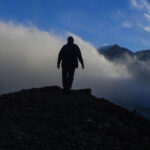There was a moment—just a moment—standing in the parking lot of the Ovintiv Centre in Dawson Creek, looking back towards Tumbler Ridge, that it felt like the end of the world.
There was a stillness about me, despite all the activity and dozens, if not hundreds of fellow evacuees.
But that wasn’t it.
It was the sky.
The sky looked like a tornado had sex with a trash fire, all grays and blacks and browns and yellows and orange. Like the world had been set on fire.
Which, I suppose, it had.
This is not the first time I’ve been run out of town due to a forest fire; like some of you, I was here in 2006 when the Hourglass fire made a dash towards… well, not quite towards town. That fire never got as close as this one did, but it was blocking Highway 52 North. With a second fire blocking off Highway 52 East, and the Hourglass making serious grumblings about jumping the river and blocking off escape from the town on Highway 29, the decision was made to evacuate the town then, too.
At 25,000 ha and change, the West Kiskatinaw fire is only 1/20th the size of the Donny Creek fire, which is now over half a million hectares.
To put that in perspective, in 2021, 869,279 ha burned, and it was the third-worst fire season the province has ever seen.
So far this season, one fire alone is more than half the size as the third worst fire season, and closing in on half the size of the worst fire year—2018—when 1.3 million hectares burned.
By itself, the Donny Creek fire would be BC’s fifth worst year for fires.
And despite what some people might tell you, it’s getting worse. Four of the five worst fire seasons have happened in the last ten years. Before 2013, only one year (1958) had seen more than half a million hectares burn.
In the last ten years, we’ve had four years where more than half a million hectares have burned.
Not every year, of course. In 2020, less than 20,000 hectares burned. That’s less trees, province wide, than the West Kiskatinaw fire has burned so far, and it’s still only mid-June.
Fires are starting earlier. Sticking about later. Last year, the Bearhole Lake fire was active almost into October. Indeed, it is still not considered out, as it could still be smouldering in the duff.
Hmm. Fires starting earlier, staying around later and doing more damage. If I were like some, I would blame the government.
Which a lot of people are doing. And it seems like they are pointing fingers at the federal government. Because the Federal government? Isn’t doing a damned thing about the wildfires in BC.
Though to be fair, they are not supposed to. Forest management is managed by the province. If the Federal government were to start sticking their nose into BC’s forestry business, people would rightly start complaining.
BC is a member of the Canadian Interagency Forest Fire Centre (CIFFC), which, according to BCWS, “coordinates inter-provincial cooperation and the sharing of resources during difficult seasons. CIFFC is a federally incorporated not-for-profit corporation established June 2, 1982. CIFFC is owned and operated by the federal, provincial, and territorial agencies responsible for wildland fire management in Canada.”
BCWS tells me that the Federal government contributes one-third of the CIFFC’s base operating costs. The remaining two-thirds of the base costs plus one hundred percent of collaborative project costs are funded by the provinces and territories on a calculated model.
But—and here’s the important part— “the Federal government does not play any direct role in wildfire management in BC.”
Some people might start complaining about the municipal government’s failure to put out the fire, but that’s just silly, because, while the municipality has a fire department, and that fire department has a wildland fire unit, their job is not to go and put out wildfires that blow up to 10,000 ha in a matter of hours. They’re not equipped for it. Remember earlier this year when someone was burning leaves, and it got away and started a bush fire? They can handle those. Or when there was a fire up at the race track, and they went and held it until BCWS was able to get a bomber on the fire? They can do that, too. But a rank five fire that’s moving at a few km per hour? Not even BCWS can do much to stop that.
So if we’re pointing fingers at the government, let’s point them in the right direction, which is the Provincial government.
And we could make an argument that the way the NDP is managing the forest is partially to blame for the fires we’ve seen this year.
Too bad there’s not a province sitting right next door to BC that—outside of a few months—has been ruled by a right-of-centre party for the last century that has done everything they can to manage the forests the right way. The Right way.
If there was, we would see that they have had no serious wildfires at all, ever. No town has ever been remotely threatened by wildfire, or burned to the ground.
If we’ve learned anything this year about wildfires is that it’s not the government’s fault. And it has nothing to do with the weather or climate or anything.
No, if we’ve learned anything it’s that radical left wing terrorists are going around and starting fires with frikken’ lasers to make it look like it was started by lightning. (That’s not a joke; Google Antifa Laser Wildfires. Okay. It’s a bit of a joke; the lasers are aliens. Or Jews. Sigh.)
Because, you know, Occam’s Razor be damned. When it comes to wildfires, the more outlandish and complicated the explanation, the more likely it is to be true.
Or at least the one more likely to be accepted.
Trent is the publisher of Tumbler RidgeLines.

